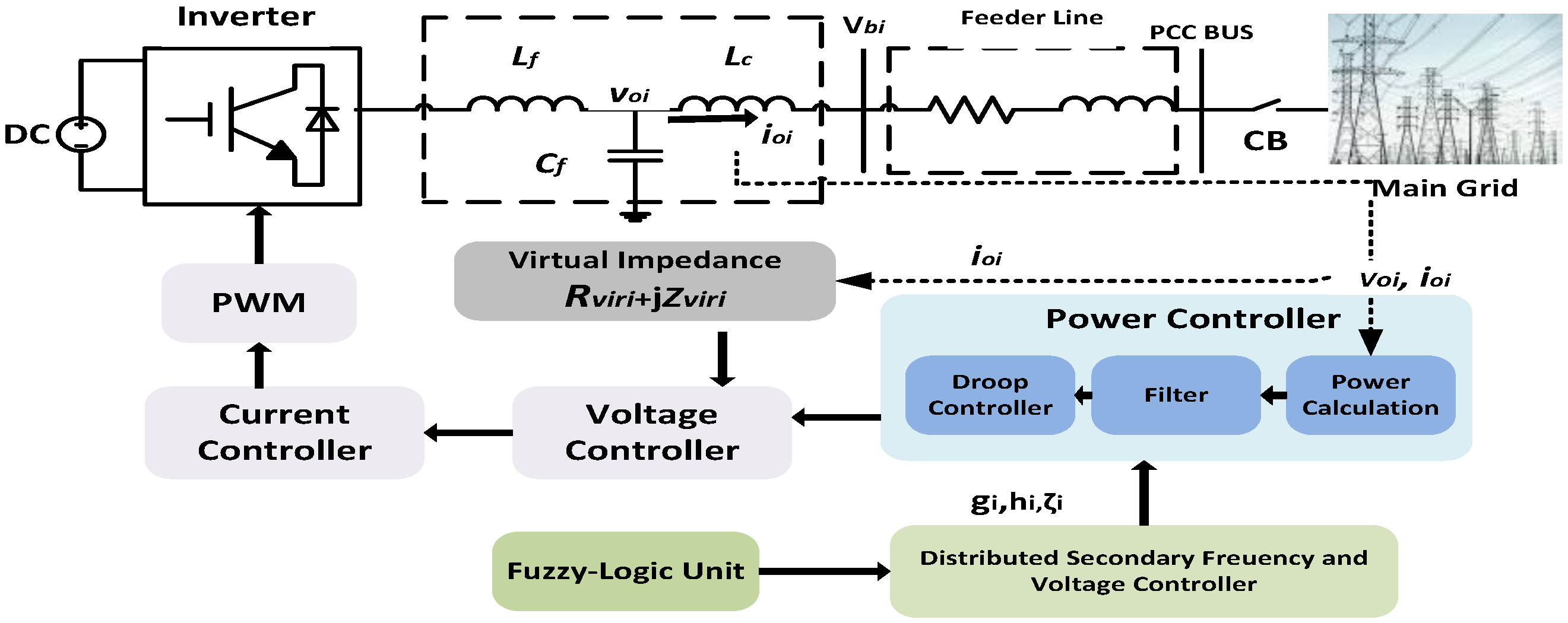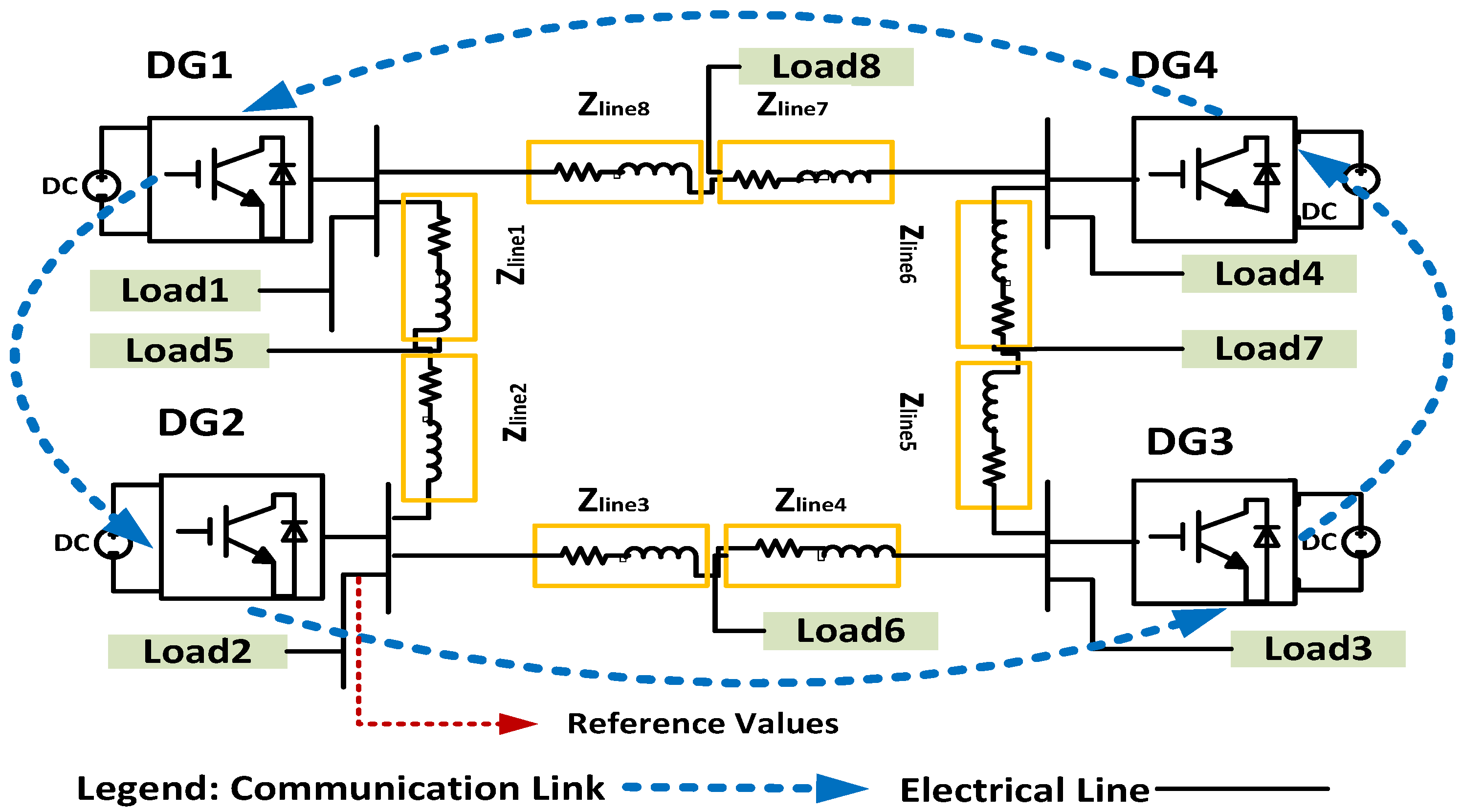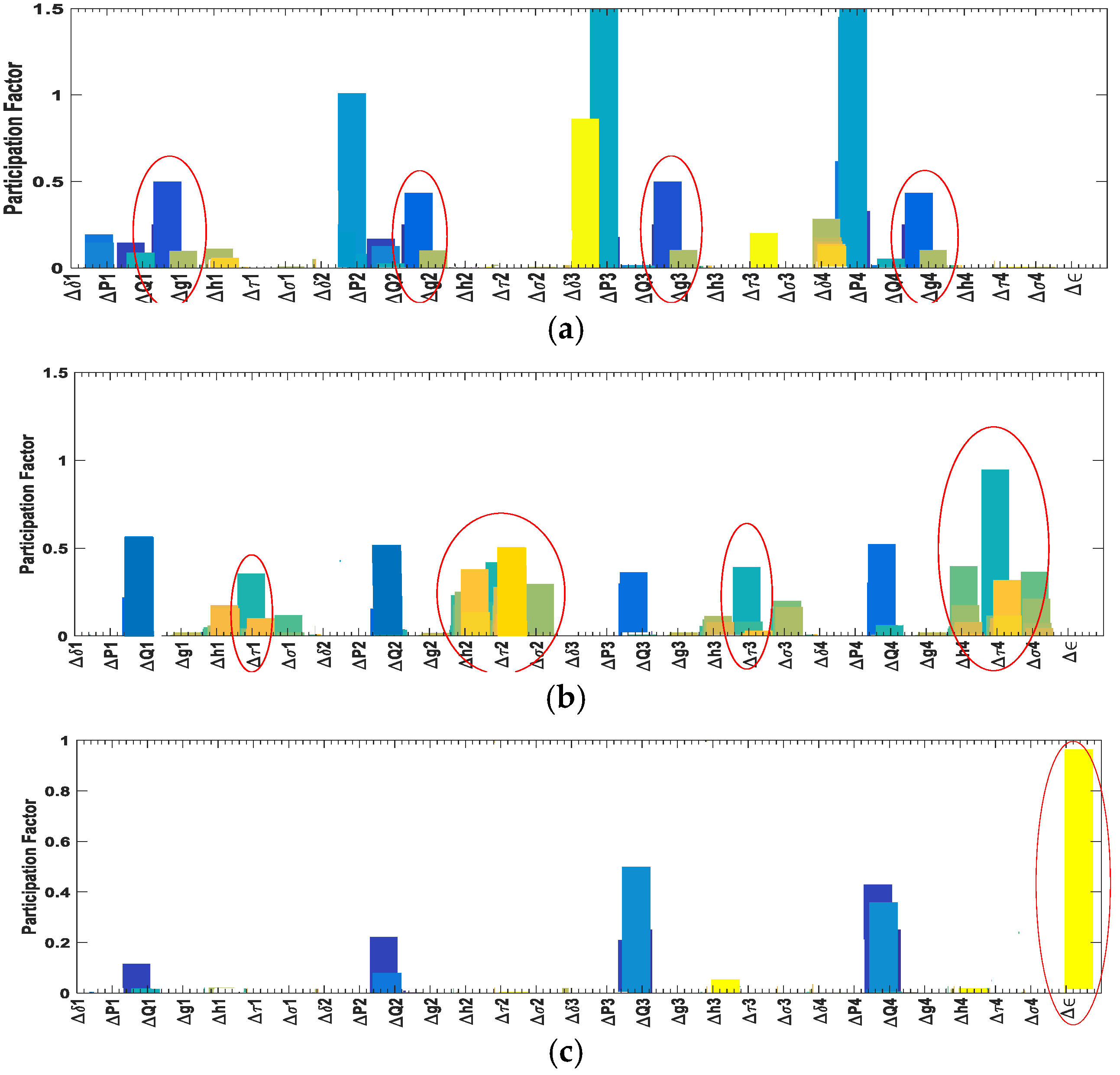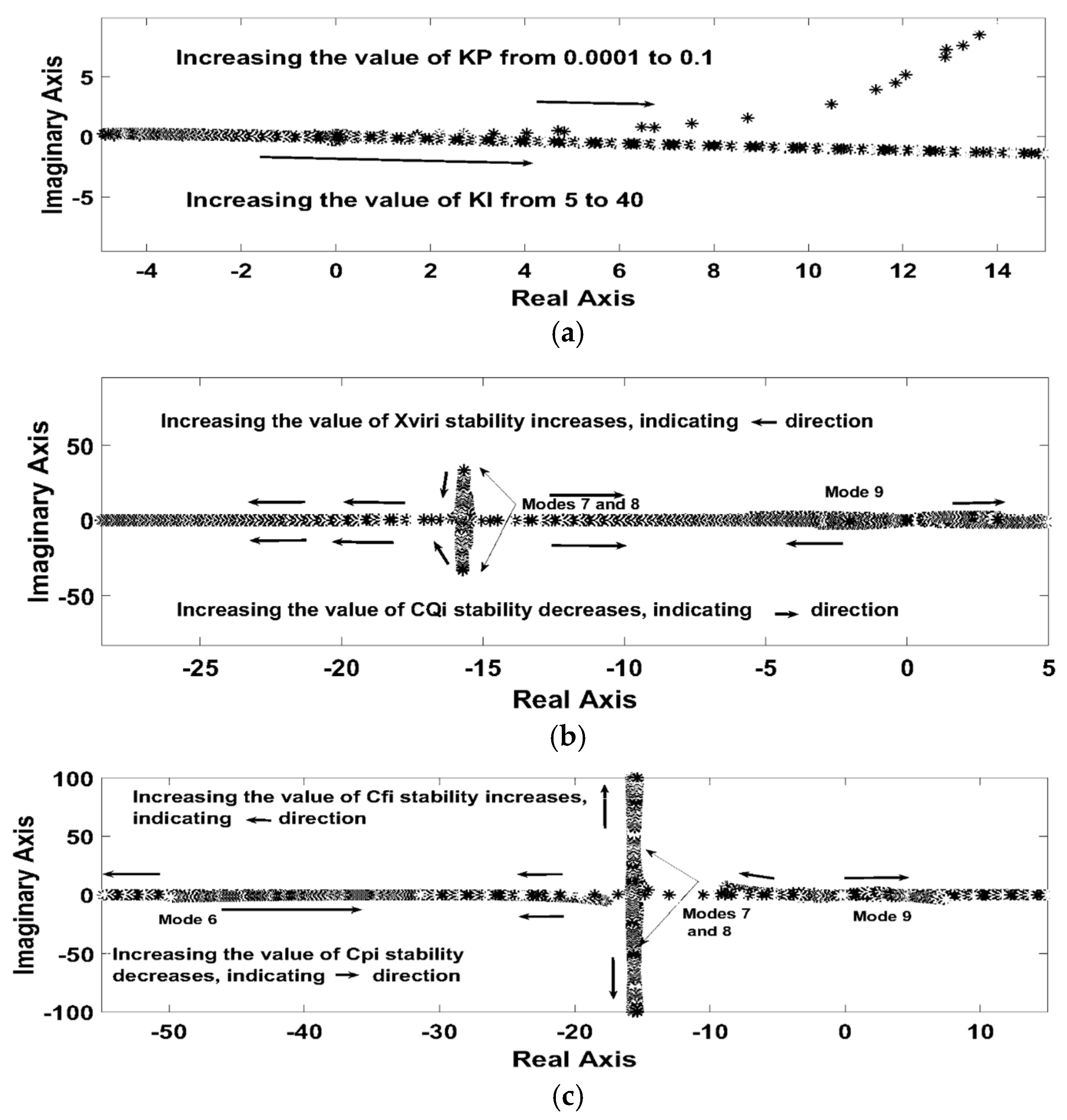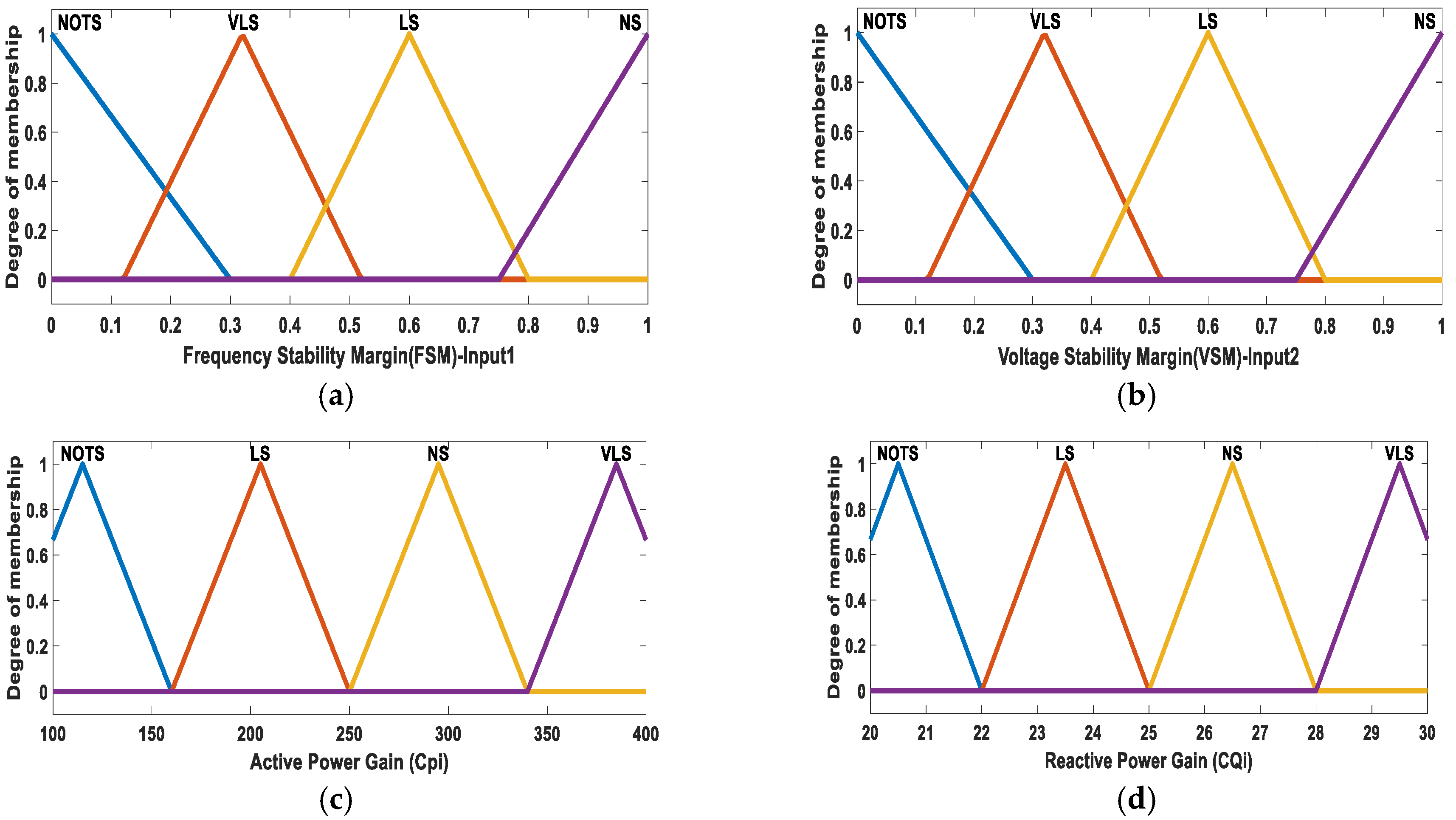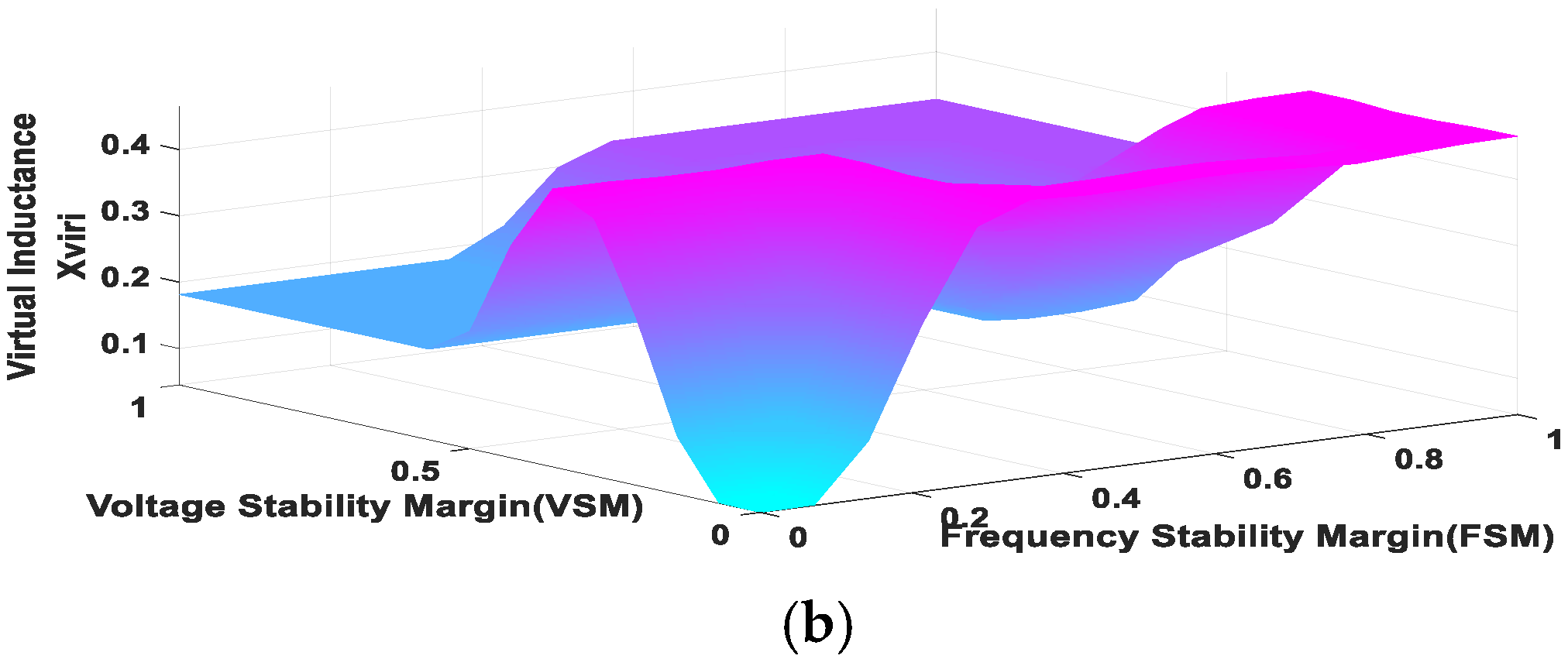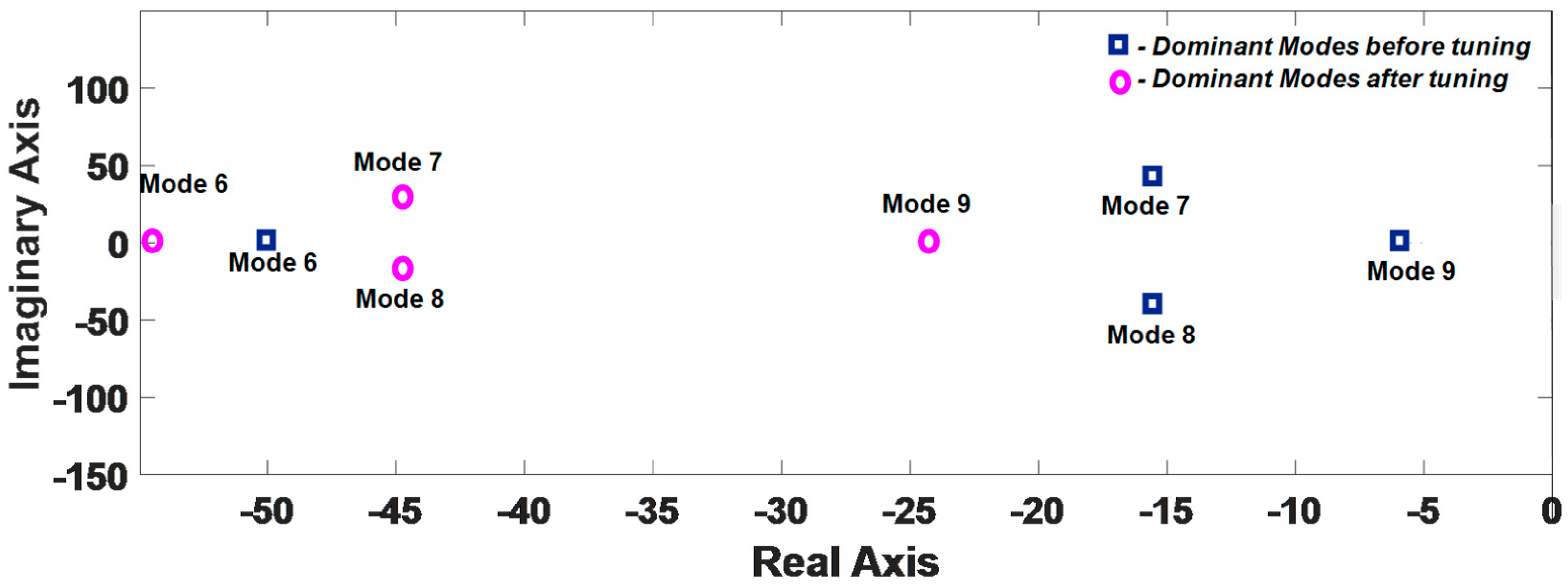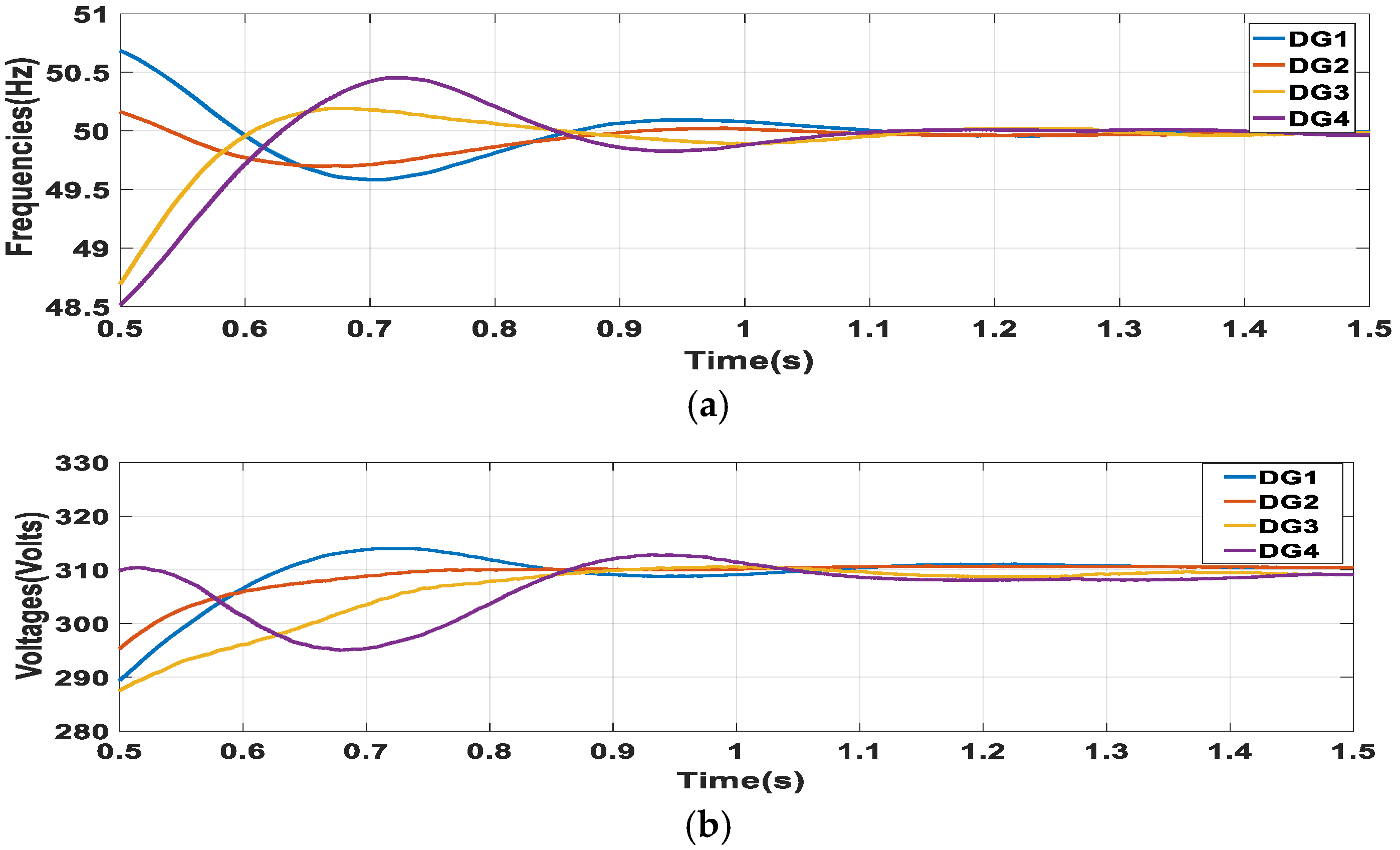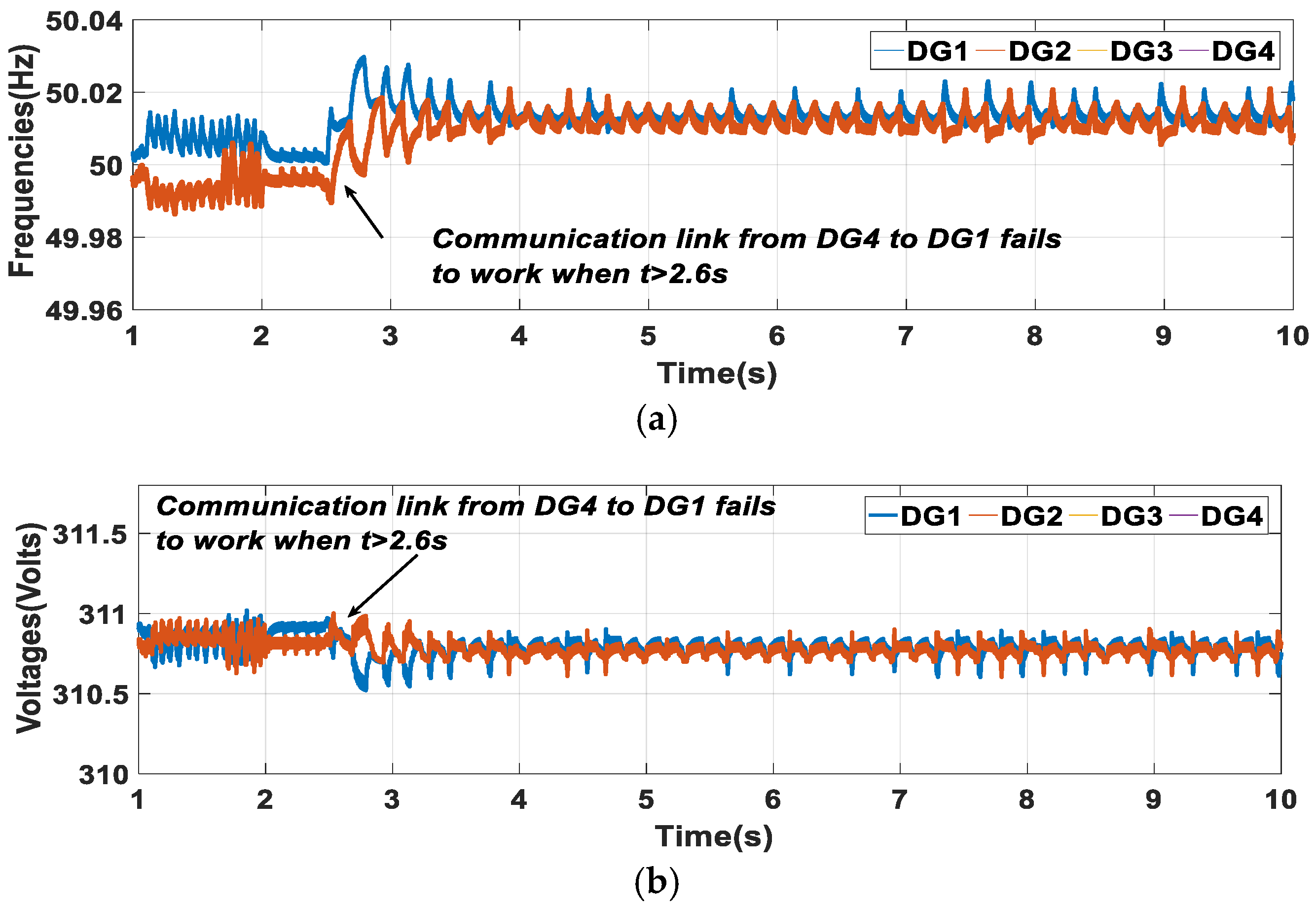1. Introduction
A microgrid (MG) (containing of small-scale developing generators, loads, batteries and a regulatory element) is defined as a regulated small-scale power network, which can be functioned in an islanded and/or grid-connected operation mode assisting the requirement of complementary power and/or preserve a usual service [
1]. Like the traditional power system, MG systems also follow the hierarchical control strategy for standardization of the MG operation and overall function. Generally, this hierarchical control system incorporates three levels, namely, primary, secondary and tertiary control layers. The traditional droop control technique considered as the most commonly used control at the primary control level because of its decentralized nature, which lessens the communication requirements [
2]. However, the primary droop control shows some other shortcomings, including its frequency/voltage deviations according to load characteristics, inaccurate reactive power-sharing, and poor performance with nonlinear loads [
3,
4]. The secondary control level is thus introduced as a complement of primary control [
2,
5]. Limitations of centralized (single-point of failure) and decentralized (poor dynamic and steady-state response) control strategies have led to distributed control structures [
3,
6]. Recently, multiagent structures or consensus algorithms [
7,
8] have received increased attention for their simple control structure utilizing sparse communication systems, improved reliability and acceptable dynamic/steady-state performance [
6,
8,
9,
10]. Nevertheless, the dynamic response of the MG considering distributed secondary control (DSC) could be unexpected in regard to the system oscillation, reaction time, stability margins [
10] and steady-state behaviour. Despite several advantages of distributed control, the limitations mentioned above are taken as key challenges for an islanded MG with DSC. The MG control system design should address these drawbacks in a proper way to maintain the stability and resilience of the whole network. In this light, the following issues should be considered in the design process.
There are many methods, studied for the development of the stability of the primary control [
11,
12,
13]. Small-signal stability is now a significant issue in the reliable operation of an MG due to low-inertia and intermittent renewables [
14]. Small-signal modelling is considered for the stability analysis for MGs with the decentralized droop control techniques at the primary level in most research works [
11]. Authors in [
15] succeeded in precise power sharing considering a consensus-based droop constant controller. Small-signal stability analysis considering DSC is studied in some recent works [
7,
8,
10,
13,
16,
17]. Additionally, the impact assessment of DSC parameters based on the dynamic model, the requirement of fine tuning of DSC parameters for stability enhancement, and the corresponding suitable solution (i.e., fuzzy-based controller) for that are not considered. Authors in [
8] study the above issue of DSC for stability analysis but the detailed mechanism of choosing the DSC parameters for stability enhancement is not discussed. A detailed mechanism study for undesired dynamic behaviour and the probable oscillations introduced by DSC is reported in [
10]. However, the use of an optimal controller for stability enhancement of the DSC leads to the system being more complex for control system design. Besides, in the majority of works, the power lines are considered to be purely inductive, which makes the models and proposed solutions inaccurate and impractical for a networked MG [
18]. References [
19,
20,
21] assume purely inductive grids used for dynamic studies of distributed secondary frequency controller (DSFC) [
20] and the distributed secondary voltage controller (DSVC) [
19,
21]. Virtual impedance is mostly implemented into the droop control for converting the feeder impedance inductive, which will decouple the active and reactive power regulation [
22,
23,
24,
25,
26,
27]. Some researchers have suggested applying the virtual impedance as a means of employing precise reactive power in MGs [
24,
27]. Another approach in [
24,
28] proposed an adaptive virtual impedance for eliminating the impedance incompatibility in the feeders. Still the stability study is unresolved, and the DG units are taken into account by means of equal rating.
Apart from this, the conventional voltage-reactive power droop control results in inaccuracy in reactive power sharing with small feeder line impedances [
18,
29]. An improved droop control was suggested in [
30], where incorrect reactive power sharing is yet noticed under clearly non-uniform line impedances. In addition, current secondary control approaches are categorized as centralized [
31], decentralized [
32,
33,
34] and distributed control [
6,
8,
9,
21,
35]. This is somewhat motivated by the cooperative control concept for multiagent structures [
6,
8,
9,
32,
33], letting all distributed energy resources (DERs) connect through their neighbours across local communication systems. Maximum distributed reactive power control (DRPC) techniques apply the voltage sensitivity analysis-based scheme [
33,
36] as per the literature for calculating the exact amount of reactive power, which each DER requires to add for confirming the system voltage maintained within allowable boundaries. Nevertheless, the sensitivity technique necessitates linearization of the power flow equations around the usual operating point, which can cause the wrong re-estimation of the necessary reactive power specifically for MG networks with low X/R ratio and high penetration of DERs. Therefore, the overall system losses are increased, which introduces a probable inconvenience on the primary distribution network including extreme requirement of reactive power.
However, another work, introduced in [
37], applies predefined equal local voltage regulator functions designed for every DER in the network. This kind of method greatly suffers from one requirement, which necessitates a thorough procedure for finding optimal parameters by tuning and describing these functions. The voltage regulation may be useless or can affect an excessive quantity of reactive power flow in the scheme without accurate tuning [
36]. To resolve this issue, suitable and efficient tuning is a prerequisite is significant to accomplish the system stability and have reliable operation against load change and large disturbance. Computational intelligence algorithms such as fuzzy logic (FL) [
4,
38,
39], genetic algorithm (GA) [
40,
41] and particle swarm optimization (PSO) [
13,
42] have been commonly used to resolve difficulty of the power system. However, some deficiencies in GA performance such as the premature convergence have been recorded. On the other hand, PSO is a population based search technique deriving from models of insect swarm. In the existing works [
43], intelligent techniques such as FL, PSO and GA are used to obtain optimal controller parameters. Authors proposed in [
41] a non-linear and non-convex optimization problem, which too contains eigenvalues constraints. Thus, PSO is adopted to solve this problem to obtain the optimal distributed control parameters. When associated with more stochastic algorithms it has been realized that PSO necessitates less computational effort. Even though PSO has presented its potential on many aspects for resolving diverse optimization problems, it still needs significant execution time to get solutions for large-scale engineering problems [
41].
Alternatively, the fuzzy logic controllers (FLCs) algorithms can tune the system constraints and outputs based on the information feed automatically to the system, which enhances the system’s simplicity and flexibility, and FLC can handle problems with imprecise and incomplete data and FLCs are cheaper to build. To reduce the complexity and enhance the controller flexibility, this paper proposed the FLC tuner for DSC. The authors in [
44] introduce a DSC framework of islanded MGs. An intelligent FL based scheme is suggested for proper tuning of the consensus parameters, but only voltage regulation and reactive power sharing are taken into account [
44]. Authors in [
45] considered both voltage and frequency regulation of an islanded MG relied on a FLC structure. Dynamics of the scheme, i.e., plug-and-play capability, and fault occurrence, are not included. Authors in [
4] proposed a novel scheme to control the reactive power nominal value of distributed generation (DG) components consistent with their involvement in reactive power sharing in islanded MG. According to the recommended method, FL is implemented to design the X/R ratio of the connecting power lines into the consensus signals in order for proper participation of DG units for precise active and reactive power sharing irrespective of the nature of feeder impedance. Although the proposed control can share the power accurately, the control level was studied for the primary control level only. In addition, the point of common coupling (PCC) bus voltage, reliant on the DSVC, essentially is being re-established to confirm nonstop action of sensitive loads. Authors in [
46] offer critical bus voltage reestablishment; though, it does not concurrently preserve precise reactive power sharing among DG units. The conventional droop control technique exhibits some other limitations such as steady-state frequency deviation from the rated value, poor dynamic behaviour and high sensitivity to measurement noises [
5,
18,
29]. Thus, conventional droop control cannot assure high accuracy of frequency control and power sharing. As a result, a secondary regulation system has been introduced to guarantee a steady frequency profile in the MG [
5]. In the existing literature for frequency control and active power sharing, secondary control systems of MGs are generally classified into three groups: centralized [
47], decentralized [
32,
48,
49] and distributed [
8,
9,
21,
35,
36,
50,
51]. The central controller for frequency restoration also faces the possibility of a single point of failure and could have trustworthiness and scalability concerns [
2,
8,
25,
31,
49]. Recently, numerous DSC strategies have been stated in the literature. Most methods are based on consensus practice [
4,
8,
9,
50,
51,
52,
53], where the agents achieve consensus by means of exchanging information over a sparse communication system. The control method described in [
51] reports simply frequency restoration through a distributed averaging proportional-integral controller but requires a centralized communication configuration regardless of its decentralized execution. In [
54], a DSFC scheme using linear input and output feedback was offered. The communication among neighbouring DG units is straightforward but power sharing is less focused. The authors in [
21,
49,
52] proposed a DSC for frequency control and accurate active power sharing in islanded MGs where the voltage regulation is not taken into account. The distributed control methodologies referred to in [
46,
55] deal with both voltage and frequency restoration, but a comprehensive model of the MG system is a prerequisite. Authors in [
56] addressed the issue of frequency restoration and active power sharing, but methods of choosing DSC parameters make the system more complex. On the other hand, DGs line, loads and MG structures are unfamiliar in reality, and the selection of controller gains are relied on the algebraic connectivity of the communication system.
However, centralized or DSC requires assistance from communication networks. Communication delay is an unavoidable and intrinsic matter for the period of the signal transmission procedure. A large communication delay can worsen the system’s dynamic behaviour, reduces the system stability margin and even causes an unstable structure [
57]. Hence, it is essential to analyse the effect of communication delay on system stability, also examine the relating delay compensation technique to get a stable system [
16,
35]. Furthermore, inevitable noise disruptions from communication channels and the external surroundings (i.e., produced by environmental reasons, for example rain, etc.) could disturb MG’s dynamic behaviour [
58]. Thus, to study the DSC problem for AC autonomous MG considering communication delay, communication link failure and noise is required. This has not been significantly or accurately reflected in a single control approach in prior research [
8,
21,
33,
35,
45]. Extensive time-domain simulations considering different case studies like communication restriction, fault occurrence and plug-and-play capability considered at the same time are not taken into account in the previous research works to verify the robustness of the DSC (see all the references mentioned in this paper).
According to the literature review, it can be realized that DSC is more effective than the centralized one [
3]. Due to the limited research undertaken so far, as mentioned in the literature review, a proper DSC is still needed that considers all the drawbacks in a single control strategy. To this end, motivated by the existing limitations, this paper proposes a new DSC, which has contributions from the following viewpoints:
A novel DSC is proposed for lossy MGs to restore frequency and voltage simultaneously while accurate active and reactive power sharing are preserved.
Unlike the existing consensus methods, the proposed method utilizes a proportional-integral (PI) controller at the output voltage of the inverter. Thus, voltage mismatches are reduced to a great extent.
The small-signal stability analysis under the proposed DSC for the networked MG model is carried out in detail. Note that eigenvalue analysis for parallel-connected DGs in the MG was previously studied in many studies, but very few studies have addressed the small-signal stability analysis for a networked MG model considering DSC.
In most of the previous related works, other tuning methods/optimal controllers are used for finding DSC parameters. Utilizing the intelligent FL parameter-tuner in accordance with small-signal stability analysis for the networked MG model has been presented as a new solution. The FLC not only enhances the performance of the proposed DSC but also reduces the complexity of the DSC design.
The rest of this paper is structured as follows.
Section 2 represents the specifics of the suggested DSC design.
Section 3 introduces the small-signal dynamic model of MG.
Section 4 shows the small-signal stability analysis, and
Section 5 discusses the time-domain simulation results. Conclusions along with future works are presented in
Section 6.
